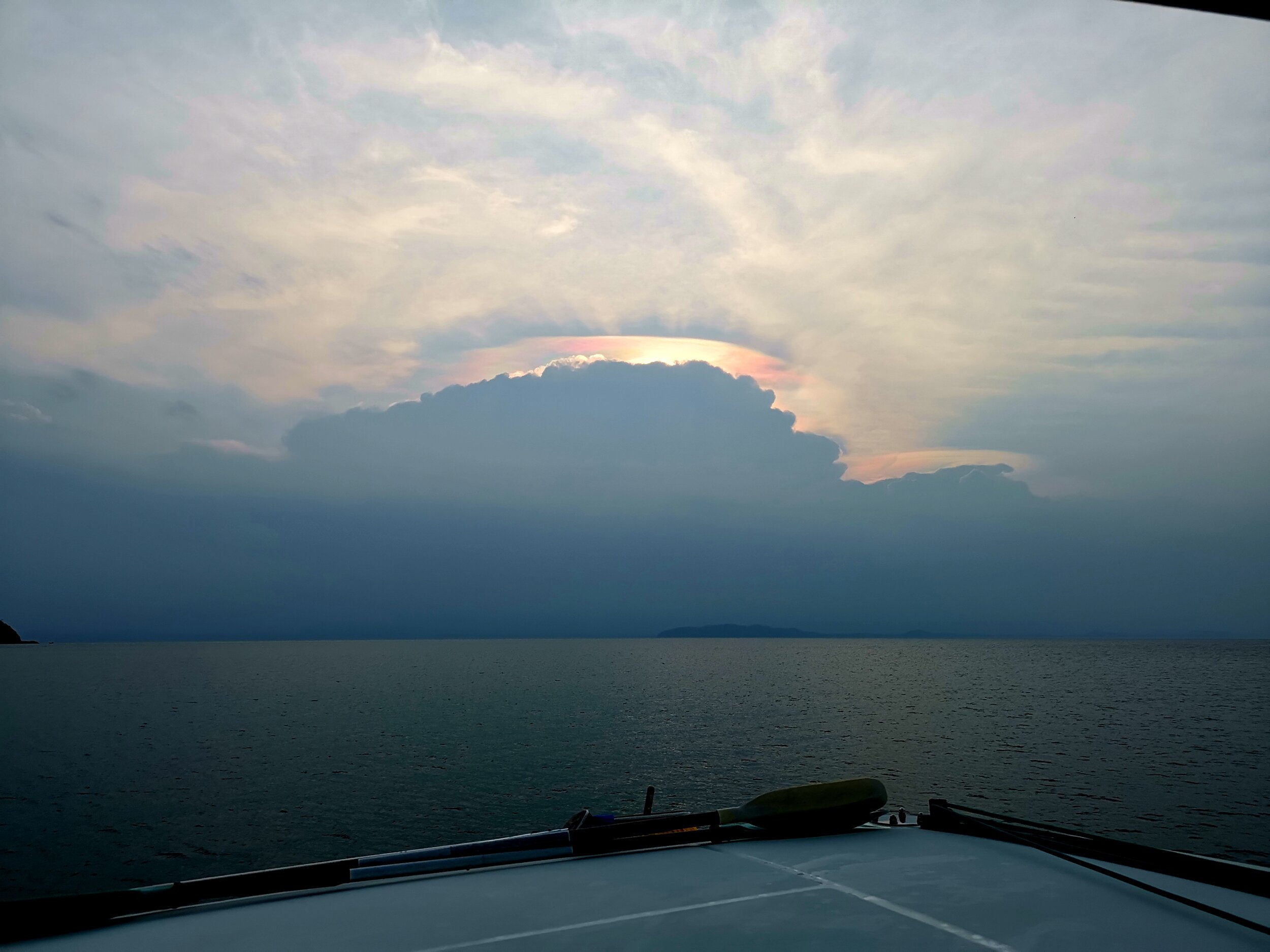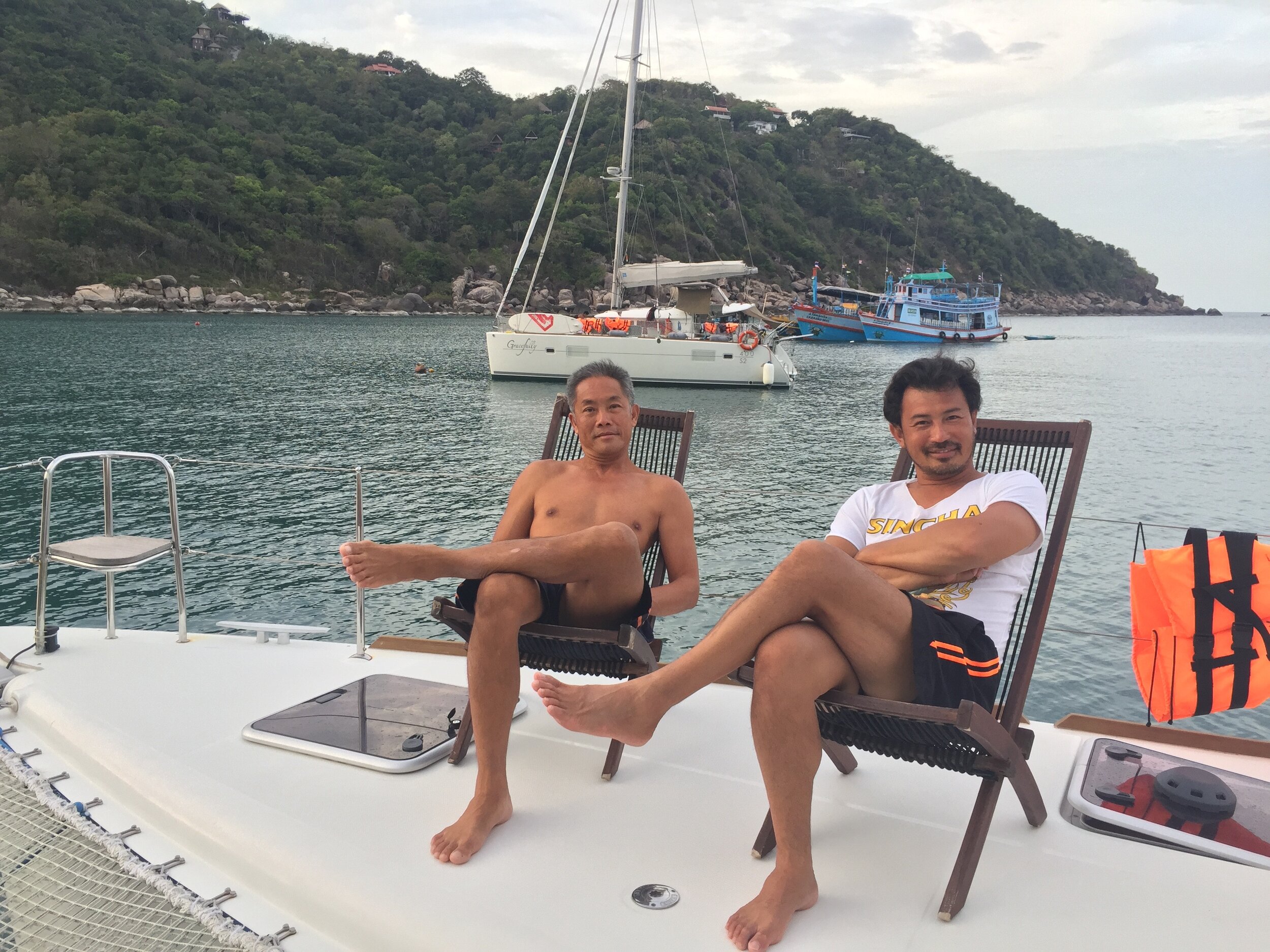Is a Sailing Holiday really worth it?
Ximula Sail has always been a passion project - our mission IS ALWAYS to inspire more fellow Singaporeans to get out on the water, and to be exposed to the wonders of sailing.
We’ve been in this project for over 5 years now, and up till today, there are still many people who are surprised to find out that sailing is an activity that can be fairly accessible to the average Singaporean, and not just a “crazy rich Asian” thing. On many occasions, as we share about the history of nearby islands, our guests are always curious to know more about how we got into sailing, and want to know more about our sailing adventures.
SO WE THOUGHT WE'LL PUT TOGETHER A LIST OF THE MOST FREQUENTLY ASKED QUESTIONS WE'VE RECEIVED ABOUT OUR SAILING ADVENTURES:
Where is the furthest you have sailed?
That really depends on who’s telling you the story. Some of our team members have sailed for only a week to the beautiful Anambas Islands, Indonesia, while some have sailed for a whole month all the way to Koh Samui, Thailand.
How far can you SAIL?
The question is not “how far can you go”, but “how far do you want to go?”
This question may seem like we’re trying to flex, but really, we’re not. It is entirely possible to go round the world by sea travel. “Circumnavigation”, the action or process of sailing, or otherwise travelling, all the way around something, especially the world, has been done many times before.
If you do a quick google search, you’ll find that there are cruise ships that you can hop on to travel around the world, or around a continent, like these round-the-world cruises featured in this article by CNN.
And, think about it: Sailing has been around for many centuries, way before the invention of steam engine ships in the 1700s. One can even say that sailing has contributed to the development of civilisations by offering greater mobility for trade and many great explorations of the world. Also, scientists have recently managed to calculate the longest straight line sail path around the world, and that route will pass through Pakistan to Russia across the Indian, Atlantic, and Pacific oceans, which is roughly 800 kilometres short of covering our planet’s circumference.
In fact, many people have sailed around the world successfully, even solo! The youngest person who has circumnavigated the globe single-handedly is 16-year-old Laura Dekker, who set off on her 40ft ketch in 2010 on a remarkable 518-day journey documented by National Geographic. And the oldest person to sail around the world non-stop, unassisted, is 77-year-old Jeanne Socrates, who completed her 320-day voyage on her 38ft boat in 2013, after at least 2 failed attempts in 2009 and 2012.
Closer to home, one of our yacht owners, TC Wong, is planning to sail from Singapore, past Indonesia, to the 118 islands of French Polynesia and beyond, beginning his journey in February this year. Our dear friend Stefan and his family, who chartered our yacht for a sailing holiday to Pulau Tioman & Aur, Malaysia before purchasing their own yacht, has also embarked on their sailing adventure setting off from Singapore in Sep 2019, and is now currently somewhere exploring magnificent atolls in the waters of Southeast Sulawesi, Indonesia.
WOW, IS IT SAFE?
Yes…. and No.
No - Sailing exposes our vulnerability to Mother Nature.
And Mother Nature is a powerful force that no one should underestimate. Commercial means of transport, such as cruise ships, ferries and even airplanes, are vehicles that allow for comfort, where you are mostly sheltered from the weather elements. On the other hand, sailing, especially on a small vessel like ours, exposes you to these elements. You will literally feel the wind in your hair. This also means that dangers in which large vehicles are well-protected against, now become imminent.
For instance, if you’re traveling on an aircraft and there is a storm, all you feel is some turbulence. However, on a sailing yacht, you will see and feel the 5-metre waves tumbling you up and down and side to side, you will see your furniture or belongings (or even yourself) rolling across the deck if you don’t secure them (and yourself), you will taste the rain pouring down your drenched face, you will feel the powerful wind possibly throwing you off your yacht if you’re not harnessed. It sounds dangerous, because it can be.
Yes - We’d say that it is as safe as you prepare.
But hardly do we encounter such chaos on our sailing trips, mostly because we prepare well and we only sail tried-and-tested routes.
Being exposed to these unknown factors therefore means it is very important to sail with crew who are experienced and well-prepared. Prior to setting off, we minimize these risks of the unknown by checking weather forecasts, including the winds, tides, storm warnings, and recent news about the route or destination. We do a thorough check and service all our engines and equipment, and stock up on our supply of spare parts and tools on board. During the journey, experienced sailors would be observant of the changing weather, and capable of navigating through these conditions.
Moreover, most of our sailing destinations are islands that you’d be familiar with, such as Pulau Tioman in Malaysia or Bintan in Indonesia, or if not, routes that have been covered by other sailors. Following these routes, our team would have done recce expeditions there as well before offering them as our destinations. We also always sail along the coast lines and never into the vast oceans, such that land is at most only a day’s sail away, in case of emergencies.
Are there pirates?
Although Southeast Asia accounts for roughly 40% of the world’s piracy attacks, we really have not met with any pirates during our sailing trips so far.
In general, real pirates have no interest in boats like ours as we do not have anything of value on board, compared to oil tankers and merchant vessels, where oil and cargo are of a much higher worth and easier to trade. On a small boat like us, the only valuable item is… well, our lives.
Prior to the trips, we will also monitor the news closely of any piracy cases within the area and avoid sailing routes or into areas plagued with piracy.
What do you do on board, during a sailing trip?
The short answer is - we snorkel, we explore the untouched islands, we learn about the tides, the wind, the waves, about how to sail and how to navigate, we connect with one another and reconnect with ourselves, we chill and relax like we've never before, and we basically have a really good time! (YAYY!)
But to look deeper in answering this question, we should ask - Why do people travel nowadays?
A sailing holiday, is really no difference from a typical holiday. Some people may travel to:
Challenge themselves
Get away from the hustle and bustle
Strengthen a relationship with their loved ones, or perhaps with themselves
Relax, rejuvenate and recharge
Expand one’s perspectives
Similarly, a sailing holiday is just like any other holiday - you get, what you would like to get, out of it.
What about food?
Our meals are planned and prepped prior to the trip, and we cook them on board our yachts! Yes, we have a fully equipped kitchen with stove and gas, microwave, oven, as well as a BBQ pit (for catch and cook opportunities!). We also stock up on snacks and staples for days when cooking is not possible (rough seas, bad weather, equipment breakdown, etc.), because nutrition is still very important out at sea.
So, how much does it cost?
AH HAH. It all boils down to this question, doesn’t it?
Let’s break it down.
To illustrate whether a sailing holiday is really worth it, let’s compare the total cost of a typical adventure getaway with that of our open sailing holiday to Anambas Islands for 2 persons.
A typical getaway comprises of 4 main costs - Travel, Lodging, Food, and Activities.
Travel
Traveling usually form the bulk of the costs of our holidays. Looking at Anambas Islands, for example, since 2018 there are more options available for the general public to get from Singapore to the capital of Anambas Islands, Tarempa.
Singapore > Batam (Ferry) > Tarempa (Flight)
This is by far the fastest and most efficient route that one can take - only about 2 hours in total. However, as Anambas Islands is not a developed tourist destination and this is a very new route, there is usually only 1 flight available once every two or three days. The average cost will amount to S$200 per trip, where:
SG > Batam (via Ferry) = S$50, 40 minutes
Batam > Tarempa (via Flight) = US$110 = S$150, 1 hour
Singapore > Bintan (Ferry) > Tarempa (Ferry)
A more cost-saving option is via ferry from Bintan, but the total travel time is munch longer at roughly 9 hours. The average cost will amount to S$145 per trip, where:
SG > Bintan (via Ferry) = S$50, 2 hours
Batam > Tarempa (via Ferry) = ~US$70 (average) = S$95, 7 hours
Singapore > Tanjung Pinang Port (Ferry) > Tanjung Pinang Airport (Land) > Matak Airport (Flight) > Tarempa (Speedboat)
One of the earliest ways to reach Anambas Islands is to travel via Tanjung Pinang instead of Batam. The total travel time will take roughly 5 hours and the average cost will amount to approximately S$185 per trip, where:
SG > Tanjung Pinang Port (via Ferry) = S$35, 2 hours
Tanjung Pinang Port > Tanjung Pinang Airport (via Land Transfer) = S$10 (approximate + tips), 30 minutes
Tanjung Pinang Airport > Matak Airport (via Flight) = S$150 (approximate), 2 hours
Lodging
Considering its exclusive and remote location, there are not many listed property options on Anambas Islands that we can utilise to make a fair comparison. Most of the accommodation on the island are either local homestays or dive resorts, so let’s take into consideration:
1 night in a typical hostel in Southeast Asia would average USD35 (S$50/person)
1 night in a dive resort, which cost about IDR1,800,000 in a room for 2 (S$90/person)
1 night in the private Bawah Reserve Resort’s One Bed Garden Suite, which cost USD1780 for 2 (S$1200/person).
Assuming that we pick the middle option and considering that our open sailing trip to Anambas is a 6-day-6-night trip, the cost of lodging can be considered as S$90 x 6 nights = S$540/person.
Food
Let’s say we have a good mix of both street food and restaurant food. A meal on an Indonesian island should average to cost about S$8-S$10, including drinks.
For our 6-day open trip, we provide a total of 17 meals, amounting to ~S$10 x 17 = S$170/person.
ACTIVITIES
These are some of the activities that we can do during our sailing trips:
Snorkelling + Island Hopping
It is possible to hire a private speedboat to bring you around to a few beautiful islands for snorkeling, which will cost approximately S$600 per day for a group of 6 people. Considering at least 3 days worth of island hopping and snorkelling, this will amount to up to S$1800, which averages to S$300/pax for 3 days.
Most travellers also recommend hiring a local guide to navigate around Anambas Islands, and there is very little tourist infrastructure nor do the locals speak much English - the cost is unknown but we’re thinking it will cost about S$100/day x 3 days split among 6 people = S$50/pax.
Diving
Assuming that a diver would go for 3-4 dives a day, our research for nearby diving spots such as Tioman and Bintan showed that each dive (day) would cost roughly S$60 per dive, including equipment rental.
During our open sailing trips, we can include 1-2 dives a day for the 4 days we are anchored at the islands, which amounts to S$240/person.
Sailing
Sailing on a luxury catamaran is a sport that not many travellers get to try their hands on. In Singapore, the price of an introductory sailing course amounts to roughly S$360/person. On board our yachts, you will get a chance to learn the basics such as navigating out at sea, points of sail, types of sails, and knots that are commonly used in sailing, and have hands-on experience on the helm and winches (with supervision from our skipper, of course).
Some Entertainment
Let’s throw in a night of drinks at one of the local bars (how can we miss that!) for say, S$50!
Adding them up…
Travel - S$400/person (two-way)
Lodging - S$540/person
Food - S$170/person
ALL Activities - S$950/person
GUIDE - S$50/PERSON
Total = S$2110 / person
The “X” factor - other additional perks
If you’ve wanted to know how it feels like to live on the sea, here’s your chance! Sailing can be quite different from what’s being shown in movies or the mainstream media.
Our team is beyond just “personalised tour guides”; we’re travel buddies that you can count on. Many of our guests who have went on our sailing trips have grown to become close friends within our community. We’re available every step of the way to make sure you stay safe and well fed throughout the journey, so you won’t feel like a castaway on a remote island.
Furthermore, as our sailboat is basically like a floating house, you’re free to leave your belongings on board! There is no need to lug around your luggage and equipment. If you need something from the boat, just come up the swim ladder and get it! You won’t have to worry about not bringing the right equipment or not having enough battery for your camera - its all just a swim away. (Can we also say that we have a legit bathroom on board? You can settle your business at ease anytime!)
In summary
We offer a pretty good deal!
Planning out the itinerary for food, travel and activities costs take time - we know. At Anambas Islands, the towns and villages are far from the conveniences we have in the city of Singapore - it is not as well-developed, and many things are not as accessible as we wished. This is what makes islands like these so charming and beautiful, yet it can be difficult if not well planned for.
At only S$2000/pax* covering all the above costs of a getaway, sailing is not as inaccessible or exclusive as most of us would think. The price is comparable to our typical holiday, yet we can assure you a sailing trip is a once-in-a-lifetime adventure and an experience far from ordinary.
*Our open trip to the Anambas Islands cost S$4000 per cabin (for 2 guests), which includes:
6D5N sailing itinerary from Singapore to Anambas Islands, Indonesia
6 nights stay on board (including first night before departure)
Shared use of our yacht among up to 6 guests on board
Unlimited use of all available equipment on board (kayak, stand-up paddle boards, floating water mats, snorkelling equipment)
1 licensed skipper and 2 crew
Fuel, water and utilities
Fruits, snacks and home-cooked meals on board prepared by crew
Free flow of coffee/tea and soft drinks (alcoholic beverages can be arranged at additional fee)
Immigration, port and customs clearance fees in Singapore and Malaysia









